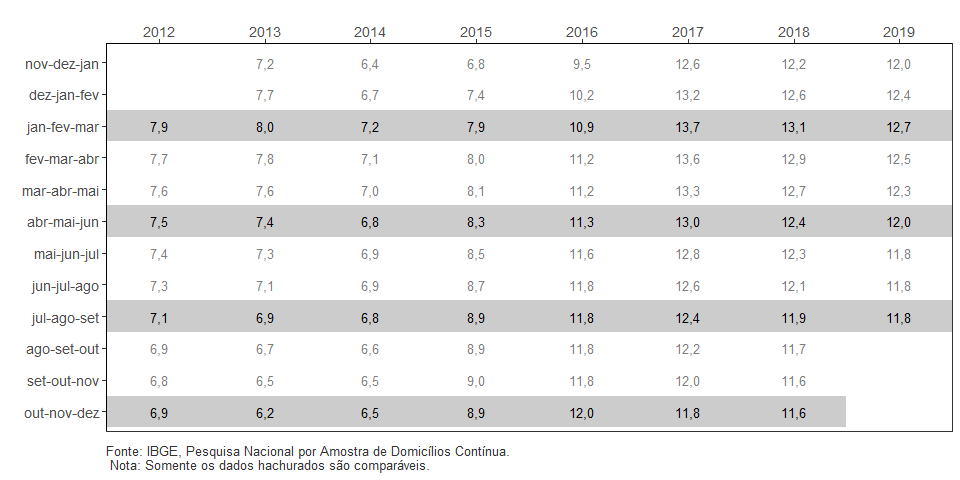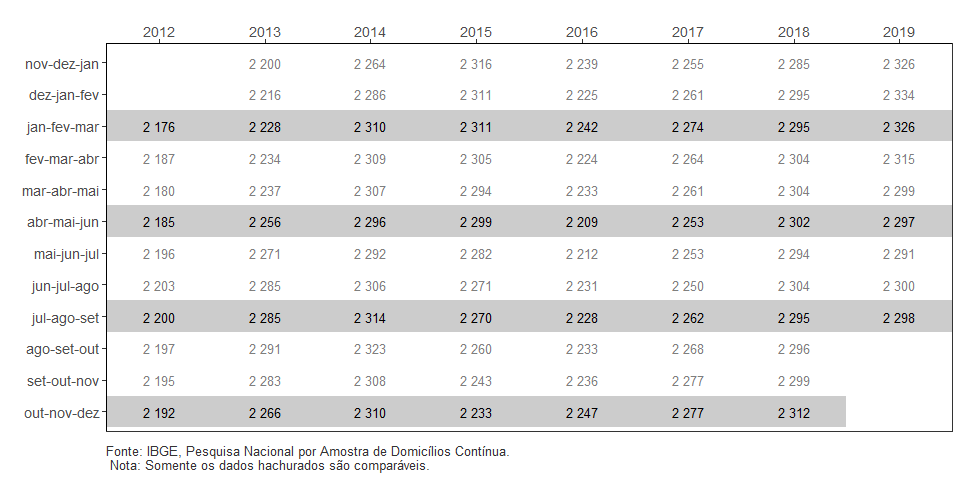Continuous PNAD: unemployment rate is 11.8% and underutilization rate, 24%, in the quarter ended September 2019
October 31, 2019 09h00 AM | Last Updated: November 01, 2019 05h57 PM
The unemployment rate (11.8%) in the quarter ended September 2019, changed by -0.3 percentage points (p.p.) in comparison with the quarter Apr-Jun 2019 (12.0%) and recorded stability in comparison with the same period in the same quarter in 2018 (11.9%).
| Indicator/Period | Jul-Aug-Sep 2019 | Apr-May-Jun 2019 | Jul-Aug-Sep 2018 |
|---|---|---|---|
| Unemployment rate | 11.8% | 12.0% | 11.9% |
| Underutilization rate | 24.0% | 24.8% | 24.1% |
| Usual real earnings | R$2,298 | R$2,297 | R$2,295 |
| Change of usual real earnings in relation to: | 0.1% (stability) | 01% (stability) | |
The unemployed population (12.5 million persons) recorded a decrease (by -2.0%, or 251 thousand persons) against the quarter Apr-Jun 2019 (12.8 million persons) and was statistically stable against the same quarter in 2018 (12.5 million persons).
The employed population (93.8 million) increased in both comparisons: 0.5% (459 thousand persons more) in relation to the previous quarter and 1.6% (1.5 million persons more) in relation to the same quarter in 2018 (92.3 million).
The population out of the workforce (64.8 million persons) remained stable in both comparisons.
The compound underutilization rate of the workforce (24.0%) changed by -0.8 p.p. in relation to the previous moving quarter (24.8%) and did not record change in relation to the same quarter in 2018 (24.1%).
The underemployed population (27.5 million persons) decreased (-3.4%, or 952 thousand persons), against the previous moving quarter (28.4 million persons) and was statistically stable against the same quarter in 2018 (27.2 million persons).
The discouraged population (4.7 million) decreased (by -3.6%, or 174 thousand persons) in relation to the same quarter in 2018 (4.7 million). The percentage of discouraged persons in relation to the population in the workforce or the discouraged population (4.2%) changed by -0.2 percentage points against the previous quarter (4.4%) and was statistically stable versus the same quarter in 2018 (4.3%).
The number of workers with a formal contract in the private sector (except domestic workers) reached 33.1 million, with stability in both comparisons. The category of workers without a formal contract in the private sector (11.8 million persons) was a record in the time series and increased in both comparisons: 2.9% (or 338 thousand persons) and 3.4% (384 thousand persons more) against the same quarter in 2018.
The category of self-employed workers reached 24.4 million persons, a new record in the time series, having increased by 1.2% (293 thousand persons) against the previous quarter and 4.3% (1.0 million persons) in relation to the same period in 2018.
The average usual real earnings (R$ 2,298) in the moving quarter ended September 2019 was stable in both comparisons, as weel as the real usual wage bill (R$ 210.4 billion) in the same period.
Unemployment Rate - Brazil - 2012/2019

The employment-population ratio – percentage of employed persons in the population at working age – was estimated at 54.8%, having remained stable against the quarter April-June 2019 (54.6%) and changed by 0.4 p.p. in relation to the same quarter in 2018 (54.4%).
The workforce (employed and unemployed persons), estimated at 106.3 million persons, was stable in relation to the previous moving quarter and increased by 1.5% (1.5 million persons more) against the same quarter in 2018.
The potential workforce (7.9 million persons) recorded a decrease (by -4.7%, or 389 thousand persons) against the previous quarter and was stable against the same quarter in 2018.
The number of persons out of the workforce in the quarter July-September 2019 was estimated at 64.8 million persons and remained stable in both comparisons.
Compound rate of labor underutilization - quarters from July to September - 2012/2019 Brazil
(%)

The number of time-related underemployed persons (7.0 million) recorded a decrease (by -4.2% or 311 thousand persons) (against the previous moving quarter and increased 3.4% (or by 231 thousand underemployed persons) against the same quarter in 2018.
The category of employers (4.4 million persons) and of domestic workers (6.3 million persons) remained stable in both comparisons.
The group of workers in the public sector– (including statutory servants and military), was estimated at 11.7 million persons and did not record statistically significant changes in either comparison.
In relation to the previous moving quarter, employment increased in one of the groups of activities: Construction (by 3.8% or 254 thousand persons more). The other groups did not record significant changes.
In comparison with the same moving quarter in 2018, there was an increase of employment in two groups of activity: Transportation, storage and mailing (by 6.1%, or 279 thousand persons) and Information, Communication and Financial, Real Estate, Professional and Administrative Activities (4.0% or 404 thousand persons more). The other groups did not record significant changes.
The average usual real earnings from the main job of all the groups of activity was stable in both comparisons.
Average monthly real earnings, usually earned in the reference month, from all jobs of employed persons - Brazil - 2012/2019 - (R$)


